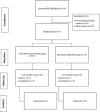Inspiratory Muscle Training in the Severity of Obstructive Sleep Apnea, Sleep Quality and Excessive Daytime Sleepiness: A Placebo-Controlled, Randomized Trial
- PMID: 33293881
- PMCID: PMC7719323
- DOI: 10.2147/NSS.S269360
Inspiratory Muscle Training in the Severity of Obstructive Sleep Apnea, Sleep Quality and Excessive Daytime Sleepiness: A Placebo-Controlled, Randomized Trial
Abstract
Purpose: Exercise programs have been considered as an adjuvant treatment in obstructive sleep apnea (OSA). However, few studies have focused on the effects of the inspiratory muscle training (IMT) in reducing the severity and the symptoms of OSA.
Patients and methods: A randomized controlled trial was conducted and approved by the local Ethics Committee. All subjects signed the informed consent form and were randomized into 2 groups: a) IMT group (n = 8), 8 weeks of IMT with 75% of maximal inspiratory pressure (MIP) and b) placebo group (n = 8): subjects performed IMT without load.
Results: IMT group showed reduction in the apnea-hypopnea index (AHI) (p = 0.01), in the Berlin questionnaire score (p = 0.001) and an increase in inspiratory muscle strength (p = 0.018). IMT group demonstrated a reduction in the AHI (31.7 ± 15.9 events/h vs 29.9 ± 15.8 events/h; p <0.001), in the Berlin questionnaire scores (2.6 ± 0.5 vs 1.2 ± 0.5; p = 0.016), Pittsburgh Sleep Quality Index (PSQI) score (7.2 ± 3.6 vs 3.7 ± 1.3; p = 0.008), in the Epworth Sleepiness Scale (ESS) (12.5 ± 4.0 vs 7.7 ± 3.0; p = 0.008) and increase in MIP (83.6 ± 26.5 cmH2O and 127.9 ± 32.5 cmH2O; p = 0.010).
Conclusion: The IMT promotes discrete changes in the AHI and improves sleep quality and excessive daytime sleepiness in OSA. Moreover, IMT is a cheap, useful and simple home-based training program and can be considered as an adjunct therapy for OSA patients.
Keywords: adjuvant therapy; exercise training; obstructive sleep apnea symptoms; respiratory exercises.
© 2020 Nóbrega-Júnior et al.
Conflict of interest statement
All authors certify that they have no affiliations with or involvement in any organization or entity with any financial interest (such as honoraria; educational grants; participation in speakers’ bureaus; membership, employment, consultancies, stock ownership, or other equity interest; or expert testimony or patent-licensing arrangements), or non-financial interest (such as personal or professional relationships, affiliations, knowledge or beliefs) in the subject matter or materials discussed in this manuscript.
Figures



Similar articles
-
Inspiratory muscle training as adjuvant therapy in obstructive sleep apnea: a randomized controlled trial.Braz J Med Biol Res. 2022 Oct 3;55:e12331. doi: 10.1590/1414-431X2022e12331. eCollection 2022. Braz J Med Biol Res. 2022. PMID: 36197415 Free PMC article. Clinical Trial.
-
The effectiveness of oropharyngeal exercises compared to inspiratory muscle training in obstructive sleep apnea: A randomized controlled trial.Heart Lung. 2020 Nov-Dec;49(6):940-948. doi: 10.1016/j.hrtlng.2020.07.014. Epub 2020 Aug 13. Heart Lung. 2020. PMID: 32800391 Clinical Trial.
-
Effectiveness of inspiratory muscle training on sleep and functional capacity to exercise in obstructive sleep apnea: a randomized controlled trial.Sleep Breath. 2018 Sep;22(3):631-639. doi: 10.1007/s11325-017-1591-5. Epub 2017 Nov 9. Sleep Breath. 2018. PMID: 29124630 Clinical Trial.
-
Effects of inspiratory muscle training in patients with obstructive sleep apnoea syndrome: a systematic review and meta-analysis.Sleep Sci. 2022 Oct-Dec;15(4):480-489. doi: 10.5935/1984-0063.20220081. Sleep Sci. 2022. PMID: 36419804 Free PMC article. Review.
-
Respiratory Muscle Training in Patients with Obstructive Sleep Apnoea: A Systematic Review and Meta-Analysis.Clocks Sleep. 2022 Apr 11;4(2):219-229. doi: 10.3390/clockssleep4020020. Clocks Sleep. 2022. PMID: 35466271 Free PMC article. Review.
Cited by
-
Pulmonary Function Test and Obstructive Sleep Apnea Hypopnea Syndrome in Obese Adults: A Retrospective Study.Int J Chron Obstruct Pulmon Dis. 2023 Jun 5;18:1019-1030. doi: 10.2147/COPD.S409383. eCollection 2023. Int J Chron Obstruct Pulmon Dis. 2023. PMID: 37304766 Free PMC article.
-
Exploring Exercise Interventions for Obstructive Sleep Apnea: A Scoping Review.J Funct Morphol Kinesiol. 2025 Jul 2;10(3):253. doi: 10.3390/jfmk10030253. J Funct Morphol Kinesiol. 2025. PMID: 40700189 Free PMC article. Review.
-
Effects of inspiratory muscle training on the severity of obstructive sleep apnea in individuals after stroke: a protocol for a randomized controlled trial.Sleep Breath. 2023 Dec;27(6):2257-2263. doi: 10.1007/s11325-023-02825-0. Epub 2023 Apr 27. Sleep Breath. 2023. PMID: 37103682
-
Inspiratory muscle training as adjuvant therapy in obstructive sleep apnea: a randomized controlled trial.Braz J Med Biol Res. 2022 Oct 3;55:e12331. doi: 10.1590/1414-431X2022e12331. eCollection 2022. Braz J Med Biol Res. 2022. PMID: 36197415 Free PMC article. Clinical Trial.
-
Effects of inspiratory muscle training on blood pressure- and sleep-related outcomes in patients with obstructive sleep apnea: a meta-analysis of randomized controlled trials.Sleep Breath. 2023 Oct;27(5):1953-1966. doi: 10.1007/s11325-022-02773-1. Epub 2022 Dec 28. Sleep Breath. 2023. PMID: 36576599
References
LinkOut - more resources
Full Text Sources
Medical

